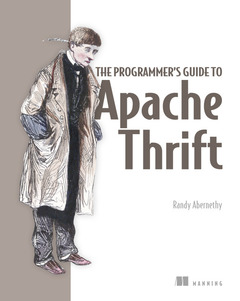Programmer's Guide to Apache Thrift
Auteur : Abernethy Randy

Programmer's Guide to Apache Thrift provides comprehensive coverage of the Apache Thrift framework along with a developer's-eye view of modern distributed application architecture. Packed with complete code examples and pragmatic discussion, this book lays the best practices for multi-language distributed application development. You'll take a guided tour through transports, protocols, IDL and servers as you explore complete example programs in C++, Java and Python. You'll also learn how to work with platforms ranging from enterprise servers to mobile clients.
About the technology
Any distributed application includes individual components, often written in different languages and hosted in multiple locations, which must communicate quickly and efficiently. Apache Thrift is a communication framework that enables cross-language remote procedure calls and serialization. Apache Thrift supports embedded, mobile, web, and server environments and a host of languages ranging from JavaScript to C++. It's perfect for back end services and embedded systems where size, scalability and performance are mission critical.
Key Features
- Clear, concise coverage of all of the primary Apache Thrift features
- Complete coverage of the Apache Thrift Interface Definition Language
- Building and serializing complex user defined types
- Working with plug in serialization protocols and data compression
- Creating cross-language services
- Tools and features to enable interface evolution
Randy Abernethy is an active Apache Thrift contributor and can be found on the dev and user email lists. A serial entrepreneur, Randy founded Hollywood's first all hard disk recording studio in the early 90s, a direct market access institutional brokerage in the 2000s, and has recently focused on the development of proprietary automated trading systems using Apache Thrift for interoperability.
Randy Abernethy is an active Apache Thrift contributor and can be found on the dev and user email lists. A serial entrepreneur, Randy founded Hollywood's first all hard disk recording studio in the early 90s, a direct market access institutional brokerage in the 2000s, and has recently focused on the development of proprietary automated trading systems using Apache Thrift for interoperability.
Date de parution : 05-2019
19x24 cm



